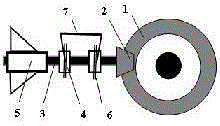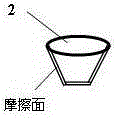Aerodynamic brake of high-speed train
A technology for aerodynamic braking and high-speed trains, applied in the direction of pneumatic brakes, hydrodynamic brakes, hydrostatic brakes, etc., can solve the problems of traction power consumption, increased impact vibration, radial cracks on the friction surface of brake discs, etc. Achieve the effects of shortening the time required for braking, reducing the probability of accidents, and making small changes to the car body structure
- Summary
- Abstract
- Description
- Claims
- Application Information
AI Technical Summary
Problems solved by technology
Method used
Image
Examples
Embodiment Construction
[0028] Describe the implementation process of the present invention in detail below in conjunction with accompanying drawing
[0029] Such as Figure 1~3 As shown, the device of the present invention includes a shaft disk 1, a friction wheel 2, a rotating shaft 3, a bearing 4, an impeller 5, a fastening ring 6, a pincer rod 7 and a driving mechanism 8;
[0030] 1) Cutting the outer edge of the shaft disc 1 into a conical friction surface;
[0031] 2) Install the axle disk 1 on the axle with an interference fit;
[0032] 3) Assemble the inner rings of the two rolling bearings 4 with an interference fit at the middle position of the rotating shaft 3;
[0033] 4) Install the impeller 5 on one end of the rotating shaft 3 with an interference fit;
[0034] 5) Install the friction wheel 2 on the other end of the rotating shaft 3 with an interference fit;
[0035] 6) Hoop the fastening ring 6 on the outer ring of the bearing 4;
[0036] 7) Connect the fastening ring 6 with the c...
PUM
 Login to View More
Login to View More Abstract
Description
Claims
Application Information
 Login to View More
Login to View More - R&D
- Intellectual Property
- Life Sciences
- Materials
- Tech Scout
- Unparalleled Data Quality
- Higher Quality Content
- 60% Fewer Hallucinations
Browse by: Latest US Patents, China's latest patents, Technical Efficacy Thesaurus, Application Domain, Technology Topic, Popular Technical Reports.
© 2025 PatSnap. All rights reserved.Legal|Privacy policy|Modern Slavery Act Transparency Statement|Sitemap|About US| Contact US: help@patsnap.com



